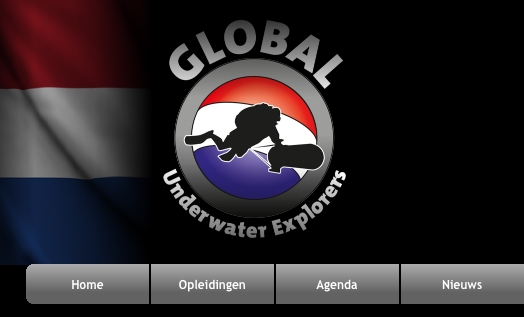|
- Cave 1 report
- By Christine Grosart
-
- In January I headed over to Amsterdam, for what is now becoming a regular visit to Cave and Wreck night, hosted by JP Bresser and GUE Netherlands. We were extremely well looked after by JP and Anne Marie and enjoyed ourselves the night before the event in the company of none other than Jarrod Jablonski.
- A few glasses of wine into the evening, I decided to build up a little Dutch courage and was nudged in the ribs by my other half, by way of encouragement, to ask him something. I wanted to know what Jarrod thought about my future in cave diving with GUE – and whether Cave 1 was the right course for me or whether I should be looking to tune up on my team skills a little more and go straight to Cave 2. Jarrod was doubtless composing in his head a well thought out and constructed, fair and sensible response. With barely a second to draw in a breath to offer his reply, JP – who was one glass of wine head of me and clearly had no idea what he was letting himself in for - said decisively;
-
- “I’ll do it. You can take the class with me.”
-
- Ten months on and I was heading down to the Lot region of France to meet up with my team mates, Maciej Orlowski and Darek Lutkiewicz. They were wreck divers from Poland and this was to be their first experience of cave diving.
- They arrived shortly after me and following introductions, it wasn’t long before JP appeared and we sat around the table to settle in and plan the week ahead.
-
- GUE course introductions are always quite interesting. They examine the divers’ motivation for taking the class, diving in the given environment and what they aspire to achieve following the course. Until now, it had all been quite straight forward for me.
- I took GUE Fundamentals because my boyfriend was the GUE director of technical training and it annoyed me that I wasn’t as good as him. I wanted a class which was concise about drills and equipment after many years of being given contradictory advice by well-meaning friends and instructors. Tech 1 was also an easy
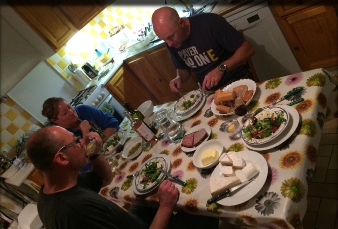 progression. I had given myself a limit of 30m depth in the sea, despite being qualified to dive deeper, which I never did. I didn’t have much confidence in the sea and Tech 1 straightened me out. To be honest, the sea scared me a little. It was beautiful for sure, but it is big, with no roof and has stinging, biting things living in it. It moved and tasted funny. It wasn’t my natural environment. progression. I had given myself a limit of 30m depth in the sea, despite being qualified to dive deeper, which I never did. I didn’t have much confidence in the sea and Tech 1 straightened me out. To be honest, the sea scared me a little. It was beautiful for sure, but it is big, with no roof and has stinging, biting things living in it. It moved and tasted funny. It wasn’t my natural environment.
-
- JP began with Darek and Maciej. They had perfectly normal and reasonable reasons for taking Cave 1. They were very experienced technical wreck divers and this was another adventure in their diving careers. They would learn skills to take away with them into their wreck diving and were keen to adventure into the underground in the next chapter of their lives.
-
- Then it was my turn.
- Maciej and Darek had already done their homework on me and JP was well aware of my experience. I had a hugely different background to everyone in the room and had no chance of hiding it.
-
- I can only just remember my first cave dive. It was June 2003. I was 23 and was being ‘brought up’ in the close knit world of caving on the Mendip Hills in the South West of England. The caves in the area had witnessed the formative years of cave divers such as Rob Parker and Rob Palmer and I appeared to be on the same learning curve. I hoped my career would end in a happier way.
- Trying to dive caves in the UK is almost a waste of time if you are not an experienced dry caver first, as many of the ‘sumps’ are some distance and many obstacles from daylight. Twinsets simply don’t fit and you wouldn’t want to carry them anyway, so sidemount is the standard in UK cave diving.
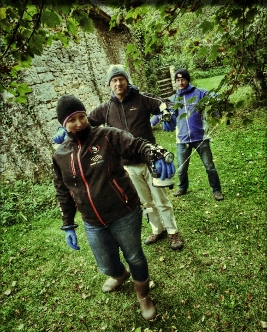 - Caving clubs are the playground for quite a few cave diving glitterati. I was heading underground with the likes of Phil Short, Gavin Newman and Martyn Farr before I even formally learned to scuba dive.
- My first cave dive was, coincidentally, with an ‘old school’ DIR diver called Andy. He had recently joined the Cave Diving Group and offered to take me to a local, well known cave which had begun the careers of so many cave divers before me.
- Armed with a single 3 litre bottle each and wearing a wetsuit and harness, we set off down the cave, negotiating cascades, waterfalls, crawls, climbs and a 9m ladder pitch, before arriving at the beginning of the series of short, shallow and mostly free-diveable sumps.
- Arriving at sump 2, I inched my way cautiously along the thick rope. With no fins and no buoyancy, visibility quickly went to zero. Surfacing in an airbell, we dived the next sump and then surfaced to ditch our gear and set off down the most beautiful, sharp and sculptured stream passage.
- My cave diving career had begun. I soon re-invented myself and changed my career path in a bid to have more time off work and more spare cash.
- I joined the Cave Diving Group and embarked on a ten year adventure of visiting places very few people have ever been and a handful of places nobody had ever been. I qualified with the CDG in 2007 and now train new cave divers within the CDG mentoring system. A few months later I had my first taste of virgin cave when a group of CDG friends and I dived 8 sumps into a system called the Calaven de Seoubio to discover new dry passage beyond a muddy climb.
- In 2008 I undertook a ‘formal’ cave diving course in the Lot with a well known technical diving agency 1:1 and although I learned plenty, it still didn’t complete the picture for me. I wanted to learn to dive twinsets and multiple stages to get further than I had been going on sidemount 15s and my awkward, antiquated aquazepp.
-
- My previous visits to the Lot region had consisted of supporting Rick Stanton in pushing the Fontaine de Truffe and Marche Pied and later on, going ‘quite a long way’ into the Ressel with 18s, stages, scooters and more courage than sense. Rich’s patience must have been endless as team diving meant little to me. The idea of sharing gas in the tight, zero visibility, grisly sumps of the UK was just not realistic. Communication was done on the far side of the sump once divers had surfaced and wearing a drysuit is a luxury.
- I was introduced to the wildly different caves of Florida in 2009. Loaded like buckaroo with a giant twinset, stages and scooters, the GUE system was starting to make sense to me, as the flow picked up the scooter and smacked me in the face for the umpteenth time…
- Exploration is what drives me to dive in caves and to be successful, you need as much skill and experience as you can possibly get. GUE Cave 1 seemed to be the obvious choice to complete the picture.
- I had been organising trips to France which yielded more virgin cave and enjoying my diving, but I still did not feel able to join GUE led expeditions and felt like I was speaking a different language underwater to the other GUE guys I had been diving with. I just didn’t ‘fit in’.
-
- I was quite honest with JP and expressed my concerns. Would I feel at the end of the class that I could no longer dive with my cave diving friends back home? Would I feel like I had lost my identity as a cave explorer if I joined the ‘gang’ of GUE cave divers? What if I failed the class? That wouldn’t look good… I had pressures which were pretty unique and I tried not to take them with me to France. I had a lot of soul searching to do and tried not to think about it too much and entered the class with a completely open mind. To achieve this, my sole preparation was to go swimming to make sure I would clear the swim test. I also spent a day at the local pond to remember how to do an S drill and a valve drill. Beyond this and a little reading, I went in to the class completely raw.
-
- To prove my point, I showed up at Moulin de Lantouy minus a second twinset.
- Just so that JP would not think I was at any kind of unfair advantage, I also cunningly neglected to print off my student file.
- There is always one. And I was she.
-
- The guys and I settled in. They had driven from Poland with no less than 30 kilos of food ‘just in case’ so there was no chance of going hungry. But we decided to spend our first evening in a restaurant in Cajarc to meet and greet. The accommodation at Moulin de Lantouy was something of a luxury. All my previous trips had been under canvas at cheap campsites, shared with spiders and toads. The proprietors Simon and Martin at the Moulin made us very welcome.
 - Day 1 was the good old GUE swim test. My team mates and I had a discussion about which pool we thought we were going to. We were pretty confident that this would be a formality, as we were all pretty good swimmers. JP appeared in the doorway to tell us that as the river was still ‘warm’ we would be doing our swim test in the Lot. Looks of somewhere between terror and sheer panic spread across our faces and our previous confidence slipped quietly out of the door, unnoticed. I knew the Lot would not have ice bergs floating down it, but I also knew it would be far from ‘warm’ like the cosy swimming pools we had all been practising in.
- Oh well. Off we went down to the river bank. It was drizzling and overcast and the river Lot had never looked so uninviting.
- I decided to warm up by doing 6 widths of the river first. It didn’t work. After several gasping attempts fighting the cold, I decided to make it harder and swim upstream against the current. JP couldn’t take any more and fished us out of the water. We all seemed to have passed.
-
- Later that evening, JP reminded me that I still needed to print off my student file or I could not dive the next day. I had emailed it to Simon and Martin to print off but received no reply. Then I remembered. They had gone back to the UK to visit family. Shit. Now I was in trouble. We scratched our heads and Darek suggested I head into Cajarc to find a friendly restaurant or bar which may have a printer. It was a long shot, but my only hope. I insisted Darek come along for moral support.
-
- It was Sunday night. Finding anything open would be a struggle. One bar greeted us with a degree of contempt and refused to help at all.The second – and last bar – was our only hope. The Hotel du Pont was open and seemed to be populated by the local football team. We nervously approached the owner and tried to explain in our best French that I was in big trouble and I HAD to get a document printed tonight and could we please borrow his printer. The friendly bar owner nodded and took my USB stick while we were engulfed by friendly and quite drunk locals, including the chef who worked at the restaurant we had visited. He duly printed my paperwork and fought our way out of the bar, promising to return later in the week.
-
- The lectures and dry land drills were as you would expect from any GUE class – concise, clean and thorough whilst remaining simple enough to implement straight away.
- Back home, the CDG mentoring system means that any qualified diver can mentor a new ‘trainee’. Trainees are required to have an open water certification and ideally caving experience, but little more. I hoped I would learn not only skills for myself, but lessons to pass on to my trainees at home.
-
- It wasn’t long before light bulbs went on and clever things started to emerge.
- Gas rules, for example. Thirds is the traditional gas rule but modified thirds are often used as most people admit that thirds can be quite aggressive. Sixths can be somewhat limiting and hold trainees back from gaining meaningful experience.
- The one third of two thirds rule was an excellent introductory gas margin and I decided that I would be trying this when I got home.
-
- It is a requirement of the class that students are prepared to be flexible. Weather and other factors can mean changes of plan at the last minute. We had a slightly different problem which required us to get up in the middle of the night to head down to the caves, not only to secure a parking spot, but to beat the Paris Pompiers, who were training in the area.
- Day 2, we woke up in the dark, attempted some breakfast and drove to the Source de Landenouse.
- I hadn’t been here for many years and tip toed to the entrance in the dark with my iphone torch. The old yellow ladder had gone and been replaced with a newly located one. I didn’t remember it as my most favourite dive on the area, but was too tired to be bothered and we headed into our vehicles to make a nest in the back and sleep for an hour until sunrise.
-
- We were woken by the sound of a lorry pulling up beside our vehicles and a very disgruntled instructor.
-
- The pompiers had arrived.
-
- They tended to hang around the first 100m of the caves and, without swimming techniques, bottom walk and disturb the visibility quite significantly. It makes teaching a class extremely difficult and unpleasant.
- We kitted up quickly.
-
- Once in the water, we went through our dive plan and headed into the cave. It was gloomy and visibility was poor in the entrance. It cleared up once inside and we set about trying to use different fin kicks and master passive light communication. Half way through the dive, complete confusion ensued and some very non-negotiable thumbs appeared….It seemed we had some tidying up to do.
- The pompiers had somehow slipped past us into the cave and bedlam broke out. The next dive meant a completely zero entrance with the added frustration of getting around the pompiers, who were hanging onto the line, pulling it into line traps and digging up the clay banks. I was beginning to remember why I hadn’t been back here in a while.
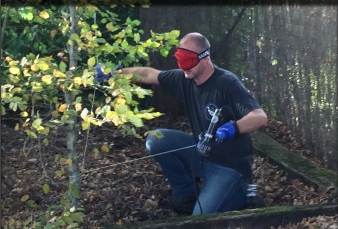
-
- The remaining dives and land drills got under way according to plan and I particularly enjoyed the ‘circuits’ around the resurgence of the Lantouy. Blind folds, touch contact and no masks were the order of the day. I had done plenty of practise with this before but it is still a worthwhile exercise and I felt quite at home unable to see anything.
- Our visit to Ressel was a similarly early start. JP decided to try different tactics to repel the pompiers and set about playing his ‘mobile disco’ complete with flashing disco lights at the back of our vans. It seemed to work. We never saw them again all week…
- We were getting stuck into the nitty gritty of valve failures, light failures, touch contact and gas sharing exits. I was borrowing Rich’s new halcyon focus light for fear of breaking the bulb of my 10W HID mid class. I was enjoying playing with it and using the ‘spread’ to light up the entire passage from the back, as a special treat for Maciej as it was his birthday. Not surprisingly, the focus instantly ‘broke’ and this set the theme really for the rest of the week. Lights, valves and even back ups continually failed or even went missing altogether. We made the most of the view on the way in, especially in Cabouy which boasted the best conditions I had ever seen. On the way out we were guaranteed to see nothing!
-
- I had tried not to predict what would be taught next throughout the course and took each session at face value. One of the topics was ‘lost diver search’. This is not something I had ever really been taught before and UK cave diving is pretty much solo based.
-
- JP set about going through the gas margins for looking for a missing diver. I was relieved that they were sensible and did not put other divers at risk at all. The techniques for looking for that diver were also well thought out and there were so many things that could be done to assist them back to the correct line home. I don’t know if it was tiredness, or maybe just mid-course emotions. JP explained multiple techniques of how to find a lost diver. Completely and utterly confused, JP noticed me first.
-
- Then my team mates realised I appeared to be crying.
-
- Doubtless thinking I was just a silly, emotional wreck of a female, they stood and waited patiently for me to explain myself.
- I had been cave diving for 11 years and during that time, had lost two close friends in cave diving incidents.
- I was not diving with either of them at the time, but was acutely aware that their deaths were needless and could have been easily avoided.
- The lost diver drill brought it all home, along with the rest of the class, that so much more can be done and learning to dive safely and keep the team safe is not so hard to achieve. Cave diving rules are there for a reason and it is no surprise that there are fatalities when they are broken. Yet divers still continue to break the basic rules of cave diving and leave the rest of us with the awful, empty loss of friends. It angered me that so much could have been done that so often isn’t done, and the outlet of that anger was tears. I pulled myself together and continued with the drill. I doubt JP had ever seen anyone take that task quite so seriously!
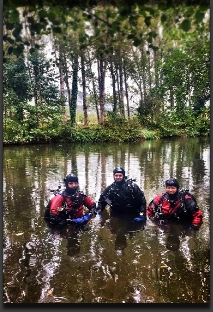 - Heading home from Cabouy, it was time to replenish our gas, do some more land drills and go shopping.
- I’m not quite sure how, but we seemed to need more food. We also needed batteries for our back ups which were getting quite a lot of burn time… The three of us ambled around the E’leclerc in Gramat, covered in Cabouy slime and hunted for nice things to eat.
- Half a minute into the trip, the team separated almost immediately and there was some buffoonery while we re-grouped and considered touch contact for the rest of the shopping trip.
- Once at the till, we queued for some time, half falling asleep when I all of a sudden remembered: “Batteries!”
-
- Looks of horror and almost panic ensued and Maciej and I sprinted for the home-ware isle, yelling:
- “Darek! Reference the line!!”
-
- Back to Landenouse and more lines got lost, more blind divers shuffled their way home in touch contact and the pompiers had given up and gone home. By the final day, I had kind of forgotten I was in France and my brain capacity would have made a mosquito proud. I was operating on complete autopilot and just doing what I was told, trying to get it right first time.
-
- Our last day was in Ressel. The first dive was a photo shoot in the shallow route which was clear and pretty. Breathing in synch with the flashes was something I was fairly used to, having often been a model for the great Clive Westlake in his ‘passages beyond sumps’ photographs. A long exposure means total stillness and no breathing as it causes steam. JP was equally demanding underwater, to avoid causing bubbles, but the results speak for themselves. I was extremely impressed that divers with only one week of cave diving experience were able to operate quite calmly in a four- way underwater cave photo shoot! The proof of the system is in the pudding I guess…
-
- On our way out, it was time for some rescue skills. I was at something of an advantage as I’d been a ‘victim’ on many occasions and knew what to do. We headed out and surfaced to talk about our last dive. JP stated “Have fun” and swam off down the Celé river!
- We looked at each other. Maciej had a grin from Paris to Gramat at finally being let off the leading rein. Darek looked completely unemotional and I was relieved as it meant that we had passed the class. It was some relief that I hadn’t spent the last 11 years doing it all wrong!
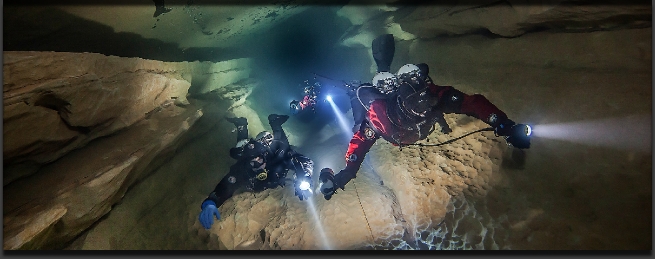 - The afternoon was spent wrapping up the exam. My maths is horrific. I actually think I’m numerically dyslexic, if such a thing exists. There was lots of huffing and puffing going on and we finally got through it. One hour’s sleep later and it was time to get up again and head into Cajarc. We had been descended upon by a gang of Portugese, led by Ricardo Constantino and a load of Dutch and a solitary Czech! The evening started in great humour with excellent food and deteriorated as the night went on, when the barman from our earlier escapade in Cajarc decided that he didn’t want to charge us any money for the Eau de Vie any more!
- We staggered, mostly sideways, in the moonlight back to the Moulin talking utter rubbish. The evening had yielded plans for exciting adventures in 2015 and new friends made who I can’t wait to dive - and go caving – with.
-
- It was definitely a wise choice to take this class, even in view of so much previous experience. The attention to detail really makes a world of difference and when the whole team is speaking the same language underwater, the efficiency and cleanness of the diving goes to a whole new level.
-
- I cannot thank JP enough for his patience and superb instruction which I hope to be putting into practise very soon.
|
|
